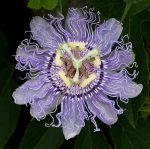 Also known as maypop, wild apricot, and wild passion vine this perennial deciduous flowering vine is native to Southeastern US where it grows near riverbanks and in thickets and disturbed areas such as pastures, meadows, roadsides, and railroads. It is a member of the Passifloraceae, a family of 750 species of mostly tropical trees, shrubs and vines, and is woody in warm climates but dies back in cold. The vines grow quickly to 6-8′ tall and sprawl on the ground or climb by axillary tendrils. They have smooth or softly-hairy stems and dark green, palmately lobed leaves that are 3-6″ long and have 3, sometimes 5, lobes, and a pair of glands at the base of the leaf stalk. The fragrant, showy flowers are 1-3″ across and have 10 white petals and sepals surrounding a crown of pinkish-purple filaments. The flowers appear from late spring to mid summer and give way to a fleshy berry known as a maypop that is 1-3″ long, egg-shaped, and pops when crushed. It is green at first but ripens to yellow in mid summer to fall and is edible to both wildlife and humans. Indigenous people used the plant as a staple food and medincinally. The edible fruit and showy fragrant flowers make passionflower a good choice for a children’s garden as well as for native plant, wildlife, butterfly, container, and medicinal herb gardens. Useful as a ground cover, the vine also looks attractive on arbors, trellises,walls and fences and grows without harming them because it climbs with tendrils. The genus name, Passiflora, comes from the Latin words passio meaing suffering, and flos meaning flower and refers to the suffering of Christ because the flower is symbolically associated with the crucifixion. The specific epithet, incarnata, is the Latin word meaing flesh-colored.
Also known as maypop, wild apricot, and wild passion vine this perennial deciduous flowering vine is native to Southeastern US where it grows near riverbanks and in thickets and disturbed areas such as pastures, meadows, roadsides, and railroads. It is a member of the Passifloraceae, a family of 750 species of mostly tropical trees, shrubs and vines, and is woody in warm climates but dies back in cold. The vines grow quickly to 6-8′ tall and sprawl on the ground or climb by axillary tendrils. They have smooth or softly-hairy stems and dark green, palmately lobed leaves that are 3-6″ long and have 3, sometimes 5, lobes, and a pair of glands at the base of the leaf stalk. The fragrant, showy flowers are 1-3″ across and have 10 white petals and sepals surrounding a crown of pinkish-purple filaments. The flowers appear from late spring to mid summer and give way to a fleshy berry known as a maypop that is 1-3″ long, egg-shaped, and pops when crushed. It is green at first but ripens to yellow in mid summer to fall and is edible to both wildlife and humans. Indigenous people used the plant as a staple food and medincinally. The edible fruit and showy fragrant flowers make passionflower a good choice for a children’s garden as well as for native plant, wildlife, butterfly, container, and medicinal herb gardens. Useful as a ground cover, the vine also looks attractive on arbors, trellises,walls and fences and grows without harming them because it climbs with tendrils. The genus name, Passiflora, comes from the Latin words passio meaing suffering, and flos meaning flower and refers to the suffering of Christ because the flower is symbolically associated with the crucifixion. The specific epithet, incarnata, is the Latin word meaing flesh-colored.
Type: Perennial flowering vine
Bloom: Fragrant, showy flowers with 10 white petals and sepals surrounding a crown of pinkish-purple filaments, from late spring to mid summer.
Size: 6-8′ long
Light: Full sun; tolerates some shade
Soil: Fertile, consistently moist, well-drained’ tolerates some drought
Hardiness: Zones 6-10
Care: Prune in late winter to early spring if needed and mulch in summer to keep roots cool; can be trained to grow on arbors and fences.
Pests and Diseases: None of significance but roots may rot in wet soil.
Propagation: Seed, root cuttings
Companion Plants: Lilac, mock orange, star magnolia
Outstanding Selections (hybrids):
‘Silly Cow’ (up to 20′ long)
“Inspiration” (light to deep purple; up to 15′ long)
Photo Credit: Oliver P. Quillia Wikipedia